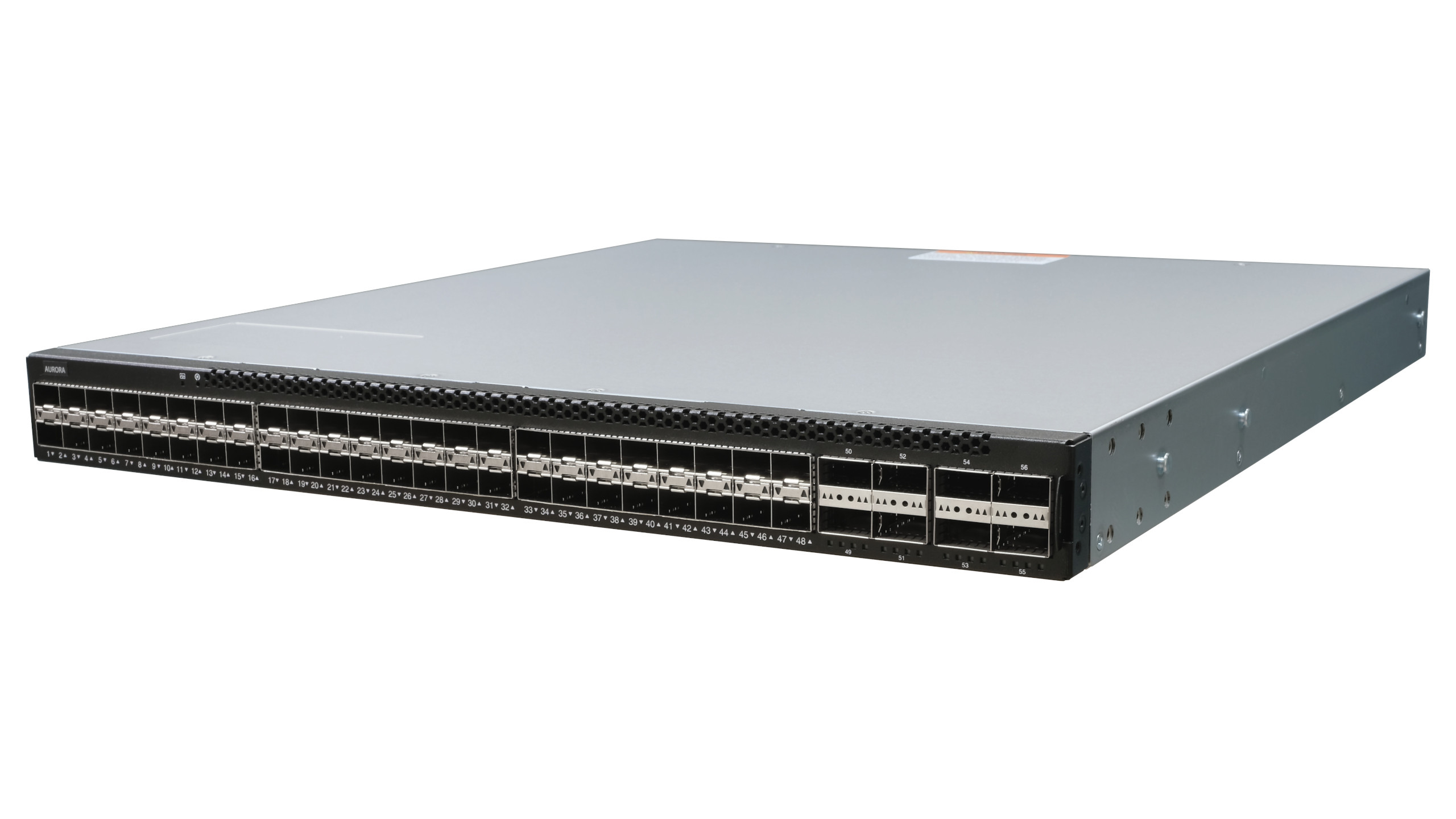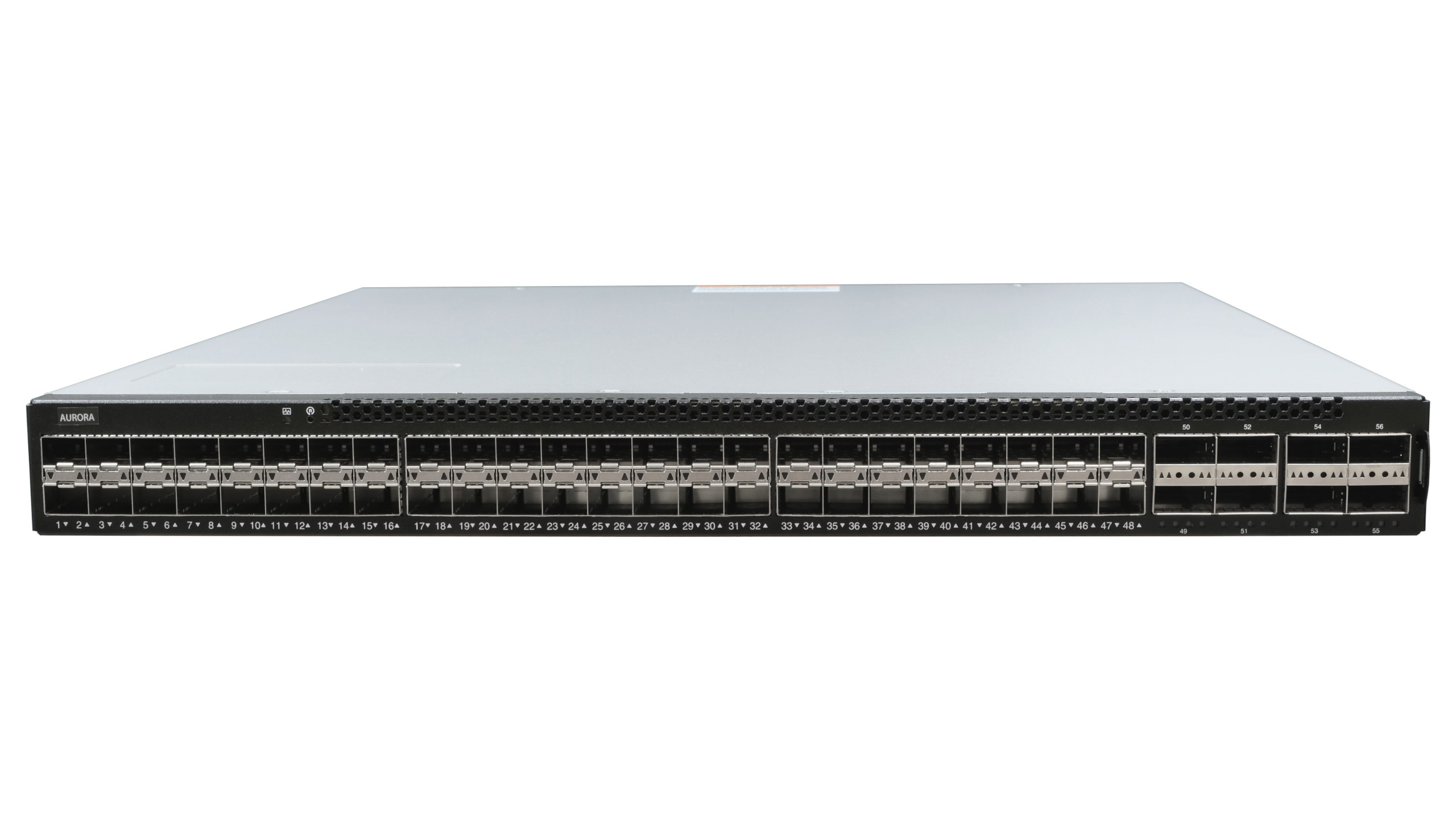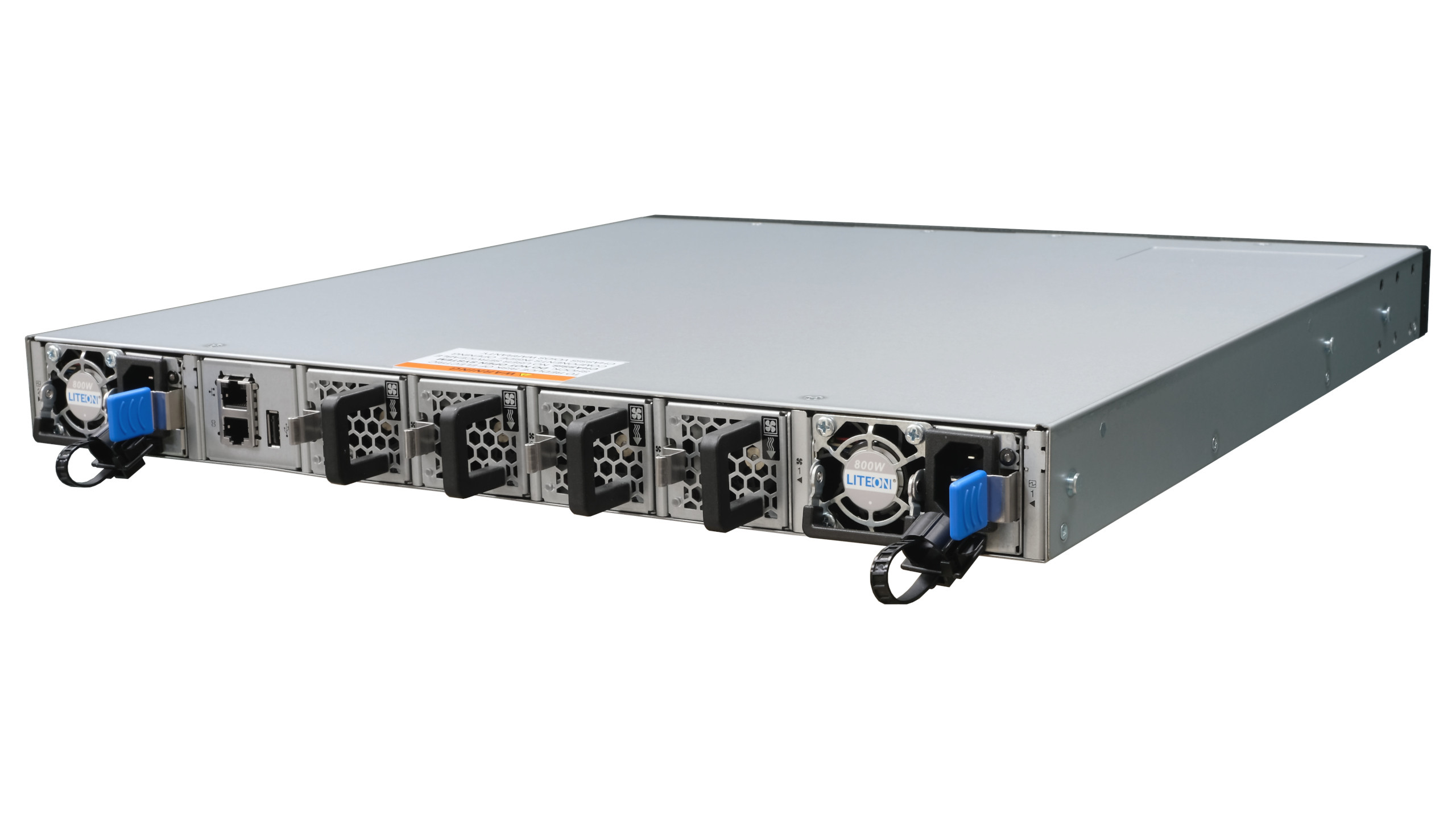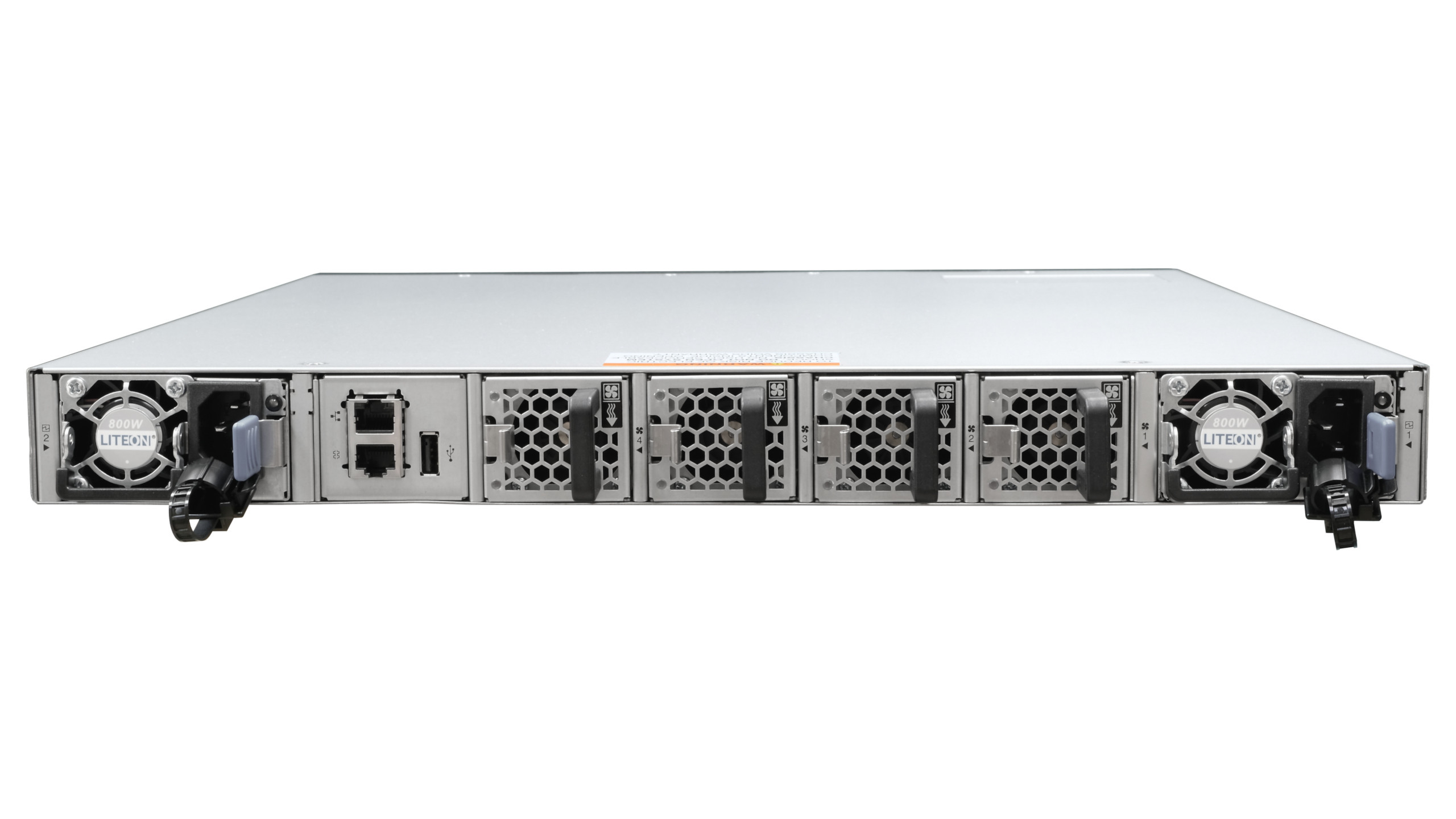PRODUCTS
EOL Aurora 610 - Intel Tofino
- 8 ✕ 100G + 48 ✕ 25G
- Intel Xeon D-1527 CPU
- SONiC ready
- Programmable pipelines by P4




Datasheet.
The Aurora 610 is based on Intel Tofino switching silicon and well-suited for Top-of-Rack/Spine Datacenter, Enterprise, and Cloud Service Provider network deployments. It has 48 x 25GbE SFP28 and 8 x 100GbE QSFP28 interfaces, which can be configured up to 80 x 25G with break-out cables for high-density scenarios, and delivers full 2.0Tbps throughput.
This model is a part of our Programmable switches for Academia and Research program.
It is a unique network development platform, designed to bring the twin pillars – performance and programmability – together for the first time in the history of networking. The combination of the Tofino programmable switch chip, the P4 programming language, and P4 Studio toolset are revolutionary.
Intel Tofino™ – the world’s fastest switch silicon, that happens also to be programmable.
P4 – Programming Protocol-independent Packet Processors – www.p4.org exists now as an independent entity to develop a rich open source ecosystem. Unlike human languages, a programming language such as P4 can unambiguously specify the behavior of network forwarding behavior. A programmer can describe the behavior once, then compile the program to run on a variety of different platforms.

InfiniCORE’s Visibility Studio transforms the Aurora 610, Aurora 710, and Aurora 750 into a visibility powerhouse, leveraging the programmability in the Tofino chipset.
P4 Studio – the compilers and development tools needed to compile and debug programs to run on Tofino.
A ready-to-use NOS, SONiC – a collection of networking software components required to have a fully functional L3 device, is available for data center applications.
Support of the Stratum project combines next-generation SDN capability with the flexibility of Tofino Match-Action Unit pipelines.
The switch has a BMC (Baseboard Management Controller) onboard to provide server-like monitoring and power control function through a shared Ethernet interface.
Use cases
- Rapid Prototyping And Deploying New Protocols.
Use intimate local expertise to introduce your own custom protocols to isolate one tenant from another while allowing interconnection of tenants with their applications.
Extend a standard encapsulation protocol to accelerate load-balancing. Implement custom congestion control mechanics, OAM, discovery, and high availability protocols. - Remove Unused Protocols, Simplify And Streamline The Network.
Precious switch resources are often hard-coded to protocols you don't use. Imagine that you can reduce the size of the L2 forwarding table and re-purpose the memory to increase the L3 IP routing tables instead. With Tofino, for example, a DC can easily increase the capacity of an IP routing table from 300K to 1.2M, allowing them to build even bigger networks and address many more servers. Throwing out unused protocols also means less to go wrong; data-center owners report outages caused by protocols they do not even use but were hard-coded into their switches! With P4, you only include the protocols you need, focusing precious tables as-needed, simplifying the switch and making outages less likely. - Ensure Complete Visibility Of The Network And How It Process Every Packet.
With P4, P4 Studio, and Tofino ASIC network operators can quickly add powerful monitoring, analysis, and diagnostics features for themselves, in the field - and our users have already started to do so. One very popular technique, made possible by P4-capable switches, is called “In-band Network Telemetry” (INT). In a nutshell, the network operator decides exactly what information she wants to observe: For example, the precise latency taken by a packet through each switch it is passes through, or the other packets it shared a queue with, the version of the software, the table entries it matched on. Every data packet can be recruited as a probe, without creating any new traffic. Such unprecedented visibility is made possible by placing programmability in the operator’s hands. And of course, a baseline implementation is already available as the open-source “INT.p4” program. Programmers are already looking at how to fully-automate data collection and remediation, as a step towards making self-managed networks. - Integrating Middlebox Functions Into Every Switch
You can program the features they need directly into your network, eliminating huge numbers of expensive middleboxes. In most cases, the middlebox functions operate much faster than before, because they run on Tofino at full line-rate, rather than on a conventional CPU. Firewalls, intrusion detection systems, address & port translators, traffic de-duplicators, etc. will benefit a lot from this approach. - Implement Part of Distributed Applications Directly In The Network.
A big data center runs many huge distributed applications; and also has a network with tens of thousands of switches. It is interesting to ask if the switches can accelerate distributed applications, offloading the servers. Recently, researchers demonstrated how the Paxos consensus protocol can be added to the network by implementing a portion of it in P4, and added to switches. This led to many of orders of magnitude acceleration of distributed applications. Other have built new key-value management services directly into the network data plane. Many new fast in-network services to be seamlessly integrated into networks, for free.
Performance
- 48x 25G + 8x 100/50/40GbE QSFP28 ports in 1 RU
Up to 80x 25/10G SFP28 port via break-out cables - 2.0Tbps Intel Tofino BFN-T10-032D-020
- 2000 million packets per second
- Configurable pipeline latency enabling sub-800 ns operation
Reliable hardware platform
- Redundant 800W 1+1 power
- Redundant N+1 cooling
- BMC (Baseboard Management Controller) enables remote switch power control and providing health monitoring of the temperature, power status, and cooling fan.
Network OS (NOS) options
- InfiniCORE Network Visibility Studio transforms the Aurora 610, 710, and 750 into a visibility powerhouse, leveraging the programmability in the Tofino chipset. Visibility Studio provides a full data path design environment known as the NextIO Design Environment right from the Web-based UI.
- Open Network Linux is a Linux distribution for "bare metal" switches, that is, network forwarding devices built from commodity components. ONL uses ONIE to install onto on-board flash memory. Open Network Linux is a part of the Open Compute Project and is a component in a growing collection of open source and commercial projects.
- Microsoft SONiC - a collection of networking software components required to have a fully functional L3 device. It is designed to meet the requirements of a cloud data center. It is fully open-sourced at OCP.
- The Stratum project broadens the scope of SDN to include full lifecycle control, configuration and operations interfaces.
Envisioned as a key software component of SDN solutions of the future, Stratum implements the latest SDN-centric northbound interfaces, including P4, P4Runtime, gNMI/OpenConfig, and gNOI. It does not embed control protocols, but instead is designed to support either an external Network OS or to work with NOS functions running on the same embedded switch. - ONIE bootloader and a set of developer tools for Linux.
Tofino gives network designers the power of the Protocol-Independent Switch Architecture (PISA). The PISA architecture was developed to provide powerful programmability.
Tofino is fully programmable because the forwarding logic resides in the P4 program that the network operator or switch manufacturer loads on the chip; it's not baked into the silicon. Tofino is protocol independent because the chip has no awareness of the network protocols it supports. Instead, the P4 program provides the logic for handling all supported protocols. When support for a new protocol is required, the network operator or switch manufacturer simply adds new logic to the P4 program.
Specification
| MSRP | Buy Tofino IFP in Aurora 610 bare metal switch preloaded with ONIE for US$7,500 |
| Ports | 48x 10/25GbE SFP28 + 8x 100/40GbE QSFP28 ports in 1 RU Up to 80x 25/10G SFP28 ports via break-out cables 1x RJ-45 out-of-band (10/100/1000) management 1x RJ-45 console (RS232) 1x USB |
| Front IO | Fan LED System status LED PSU status LED Reset button |
| Performance | Switching silicon: 2.0Tbps Intel Tofino Intelligent Fabric Processor BFN-T10-032D-020 Forwarding rate: 2000Mpps Latency: <800 ns (PHY-less) Packet Buffer: 20MB Intel® Xeon D-1527 CPU 8GB DDR4 ECC (up to 16GB) 128GB M.2 SSD |
| Management | ASPEED AST2520 BMC IPMI 2.0, shared Ethernet port |
| Power | 800W 1+1 RPSU 80+ Platinum: 100V~240V AC / 50~60Hz 240V DC 800W 1+1 -40V~-60V DC RPSU (option) |
| Cooling | 4 N+1 redundant fans Front-to-Back |
| Dimensions (DxWxH) | 1U, 505 x 440 x 44 mm Rackmount kit (option) |
| Environment | Operating temperature: 0~45°C Operating humidity: 20-95% maximum relative humidity (non-condensing) |
| Warranty | 3 year |
| EMC and safety | FCC CE Declaration of Conformity Reduction of Hazardous Substances (RoHS) 6 |
| Compatible NOS | ONIE bootloader Open Network Linux, the open-source, OCP reference NOS Ubuntu 20.04 and a set of developer tools Stratum SONiC (Software for Open Networking in the Cloud) InfiniCORE Network Visibility Studio |
| Netberg SONiC | SONiC.202111 Layer 2: * LLDP Link aggregation: * LAG 802.3ad with LACP * LACP Fallback * MC-LAG (L2) VLAN: * IEEE 802.1Q * Port-based * Vlan Trunk Layer 3: * FRR as default routing stack * BGP ** BGP Graceful restart helper ** BGP MP ** FRR BGP NBI ** BGP/Neighbor-down fib-accelerate ** IPv6 Link Local and BGP Unnumbered * ECMP ** Consistent ECMP (fine grain ECMP) * Proxy ARP * Mgmt VRF * VRF * L3 RIF counter support * SONiC for MPLS Dataplane QoS: * QoS - ECN * QoS - RDMA * WRED * COS Management: * Standard Linux shell tools * Linux application integration * Industry standard CLI * CLI filtering * Telnet/SSH * SNMP * Warm Reboot * Incremental Config (IP, LAG, Port shut/unshut) * CoPP Config/Management * Streaming telemetry * sFlow * Syslog * Sysdump * NTP * DHCP Relay Agent * Fast Reload * Critical Resource Monitoring * MAC Aging * gRPC * Sensor transceiver monitoring * Routing Stack Graceful Restart * Port breakout * Port Mirroring * Everflow V2 - IPV4/IPv6 Portion 2.0 * Sub-port support * Configurable drop counters * HW resource monitor * NAT * LLDP extended MIB * SONiC to SONiC upgrade * One Image * MAC Aging * MTU Setting Security: * ACL permit/deny * IPv6 ACL * Dynamic ACL Upgrade * TACACS+ * RADIUS AAA * Egress mirroring and ACL action support * Egress shaping (port, queue) Data Center: * Priority Flow Control ** PFC WD ** Asymmetric PFC ** PFC Watermark * Tunnel Decap * L3 VXLAN * BGP-EVPN support(type 5) * EVPN/VXLAN * Dynamic headroom calculation (RoCEv2) * Dynamic policy based hashing for NVGRE/VxLAN packets * PINS (P4 Integrated Network Stack) |
